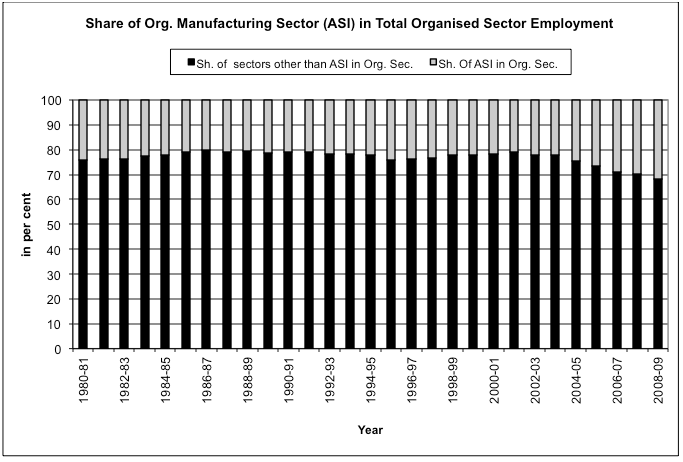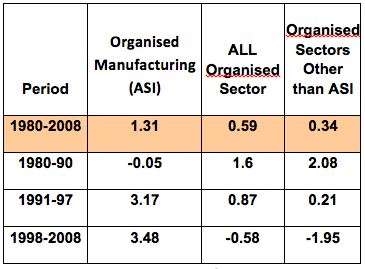A Reality Check on the Labour Market Flexibility Argument in India-Anamitra Roychowhury
The standard
arguments for undertaking labour market flexibility (LMF) in India are well
known. With the exception of few misleading media reports, that attribute the aggregate employment slowdown in India
(the phenomenon of ‘jobless growth’) to the so called labour market rigidities,
it is generally accepted even by the most ardent advocate of LMF that the
labour laws could not possibly be the
primary reason behind the recent employment debacle. This is simple to
understand. Since the vast majority of our workforce (92 per cent) is employed
in the unorganised sector, mostly falling outside the ambit of labour laws, it
is difficult to argue that the prime reason for aggregate employment stagnation
is due to the labour laws. Nonetheless, commentators are quick to point out
that the labour laws act as a barrier to ‘quality’employment generation in the
organised sector. Their basic argument is aptly summarized below: “Labour
market rigidities constrain growth in employment … In absence of flexible
labour markets in the organised sector (less than 8 per cent of the labour
force), growth in output does not necessarily lead to an increase in
employment, because labour effectively becomes a fixed input. Hence, production
becomes artificially capital intensive. In an attempt to protect existing jobs,
future and potential jobs are lost. Thus, the system is not in the broader
interests of labour either. In addition, labour legislation creates relatively
high wage islands in the organised sector and India’s comparative advantage in
an abundant supply of labour cannot be tapped … Conversely, the unorganized
sector (92 per cent of the labour force) has virtually no protection” (Debroy,
2005)
discussion it is clear that labour laws are identified to be the major reason
for the slow growth in employment in the organised sector. It is further
contemplated that the labour laws contribute to form a dual labour market,
producing a minute constituency of labour aristocracy at one end with a vast
majority of working paupers at the other. Therefore, to generate quality
employment and remove the distinction between formal and informal workers, it
is argued that India must introduce LMF. In what follows we shall examine the
validity of these claims.
legislation that has drawn maximum attention in the labour flexibility argument
is Chapter VB of the Industrial Disputes Act, 1947 (IDA). It stipulates that,
if an undertaking (engaged in manufacturing, mine and plantation activity)
employing 100 or more permanent workers wants to fire even one permanent
worker, then it has to obtain prior
permission from the government. This, it is argued, creates unnecessary
deterrence in quickly responding to the fluctuations faced in the product
market and makes the firm uncompetitive, thus hindering its capacity to
generate employment. This sentiment is
clearly reflected in the following: “In face of adverse shocks employers have
to reduce the workers’ strength; but they are not able to do so owing to the
existence of stringent job security provisions. On the other hand, when the
going is good and the economic circumstances are favourable, the firms may want
to hire new workers. But they would hire only when they would be able to
dispense with workers as and when they need to. Thus, separation benefits
accruing to workers become potential hiring costs for the employers. This
affects the ability and the willingness of firms to create jobs” (Sundar, 2005)
question arises, is it correct to ascribe the failure of the organised sector as a whole,
in generating formal jobs, primarily to the rigid labour laws? A close reading
of the domain of application of Chapter VB (IDA, 1947) reveals that it applies
to only manufacturing units, mines
and plantations – and not to firms
providing services or, related to agricultural activity. However, firms
employing 10 or more workers qualify for the ‘organised’ sector irrespective of their nature of activity
(Indian Labour Year Book, 2007 p.2). As figure 1 shows that the share of
organised manufacturing sector workers [where restriction on firing workers
applies; data obtained from Annual Survey of Industries (ASI)] in total organised workforce has been
persistently below 30 per cent for the whole period under study (except for the
last year, 2008-09).
Organised Manufacturing Sector from ASI, various years and Total Organised
sector employment data from DGET, various years.
the discussion just carried out it is clear that job security regulation
applies only to a subset of the total organised
sector namely, organised manufacturing sector (constituting less than 30 per
cent of total organised workforce) and does not extend to the organised
sector as a whole. Therefore, it is patently wrong to
identify the labour
laws for explaining the slowdown in employment growth of the overall
organised sector – since employment protection
laws apply to less than a third of
the total organised workforce, namely organised manufacturing sector.
different segments of the total organised sector and compare it with the
organised manufacturing
sector. For this refer to table 1 below.
the Organised Sector (in per cent)
Same as figure 1
column depicts the growth rate of employment in the organised manufacturing
sector i.e. where labour laws apply. In the third column employment growth of
the organised sector as a whole (including organised manufacturing) is
calculated. Finally, the last column shows the growth rate of employment in the
organised segment (excluding organised manufacturing). It is easy to see from
the table that in the long time period [i.e. 1980-2008] the employment growth
in organised manufacturing sector (where labour law applies) is greater than both the organised sector
as a whole, as well as, the section of organised segment other than organised
manufacturing. This holds true for the sub-period analysis except for the
sub-period 1980-1990[1].
Thus, it may be concluded that the organised manufacturing sector (where the
law stipulates firms to take prior permission for firing) actually boosted the
employment growth in the overall
organised sector (other than the sub-period 1980-1990) rather than pulling it
down. Thus, there is little evidence to suggest that the slowdown in employment
growth in the organised sector as a whole
was due to the labour laws. [Sluggish growth in overall organised sector employment is actually explained by the failure of the public sector to generate
formal jobs – a direct fallout of the conscious policy decision by the State.
In fact there is also evidence on employment growth being higher in those segments of organised
manufacturing where labour laws apply compared to where it does not apply (for a discussion on these issues see
Roychowdhury, 2013)].
the question, whether labour laws produce duality in the labour market by
creating a small group of labour aristocracy located within a vast pool of
informal workers. The basic argument is quite simple – labour laws by extending
protection of employment increases the bargaining power of workers, which in
turn is utilized by them to jack up wages. As Ghose (1994) puts it – “A popular
perception in India today is that rising labour costs [i.e. wages], [are]
attributable to labour market rigidities generated by inappropriate [labour]
regulations …”. On the other hand, since informal workers are not protected by
labour laws – their wages remain low. Note that in this argument one section of
worker is pitted against another section; with an attempt to deviate our
attention from the class distribution of income.
armed with employment protective legislation, could raise their wages due to
enhanced bargaining power then we would expect the share of wages in total
output [gross value added (GVA)]to progressively rise overtime. However, from
figure 2 it is clear that the available evidence is at odds to substantiate
such a claim. There is almost a secular decline in the share of wages to output
– in fact the wage share in organised manufacturing has come down to less than
10 per cent in the most recent years. So, if wage share is taken as an
indicator of the relative bargaining position of labour vis-à-vis capital – it
is clear that the bargaining of the workers weakened over time, even in a
sector where labour is statutorily protected by law. To be sure, workers in the informal sector
might have received an even more raw deal, but the whole point is the position
of the organised manufacturing workers deteriorated as well. By no means can
the organised manufacturing workers (with a wage share of less than 10 per cent
of GVA) be demarcated to constitute a labour aristocracy.
little further. There is evidence of increase in informal employment within the organised manufacturing
sector. Remember, the law requiring prior permission from the government for
carrying out retrenchment and layoff applies only to permanent workers and not to the workers employed through
contractors (contract workers). And we find that the share of contract workers
in total workers has increased consistently over time (figure 3). By now it is
one-third of the organised manufacturing employment – precisely the sector
where labour law applies. Thus, any claim of labour aristocracy in midst of
rising informal employment is premature.
advanced in favour of LMF can be logically sustained. Nonetheless, undertaking
LMF has far reaching implications. It is easy to see that the demand for labour
flexibility, by invoking the labour aristocracy argument is actually a strategy
to divide the working population. By inventing the conflict of interest among
different segments of the working population, LMF actually wants to further the
interests of capital vis-à-vis labour as
a whole. In fact to introduce LMF for rapid growth in ‘quality’ employment
is a contradiction in terms; this is so for once LMF is introduced, ‘quality’
itself is degraded. Similarly, appealing to the labour aristocracy argument is
inverted logic; if a small section of working population is better off than the
vast majority of the working poor, then in the quest for obtaining a
homogeneous workforce, we must search for strategies to improve the conditions
of the informal workers rather than worsening the position of the formal
workers.
and P.D. Kaushik, ed., Reforming The
Labour Market (New Delhi:
Academic Foundation).
in Organised Manufacturing in India’,
The Indian Journal of Labour Economics, Vol. 37 No. 2: 143-162.
Government of India.
Market Flexibility and Conditions of Labour in the Era of Globalisation: The
Indian Experience, unpublished Ph.D thesis submitted to Jawaharlal Nehru
University, New Delhi.
Comprehensive Review and Some Suggestions’, Economic and Political Weekly,
May 28: 2274-2285.
faculty of Economics at St. Stephen’s College, New Delhi.
employment in the sub-period 1980-1990 is not
due to labour laws but the way ASI enumerates workers and the underlying nature of technical progress (notably
labour saving variety). For details see Roychowdhury (2013).







